Kathy Lynn Emerson's Blog, page 91
November 4, 2015
Yes! You are allowed to leave your desk
 Hi, it’s Kate Flora, and today I played hooky. With the holiday season approaching, and deadlines looming, it is hard to admit this, but yes, I left my desk, did not make my daily word count, and generally misbehaved. I didn’t read the two books I still need to finish for the panels I have to moderate at a conference this weekend, never mind the two about deadly force encounters and Decisive Force Response. I didn’t trying to knock down the next chapter in my latest nonfiction project, and I rudely stopped President Obama in the middle of his speech to the International Association of Chiefs of Police. Instead, I laced on my walking shoes (Goretex, North Face, courtesy of the Brunswick Salvation Army store) pulled on a sweatshirt (DKNY, Portland Goodwill), and headed out into a gorgeous fall day.
Hi, it’s Kate Flora, and today I played hooky. With the holiday season approaching, and deadlines looming, it is hard to admit this, but yes, I left my desk, did not make my daily word count, and generally misbehaved. I didn’t read the two books I still need to finish for the panels I have to moderate at a conference this weekend, never mind the two about deadly force encounters and Decisive Force Response. I didn’t trying to knock down the next chapter in my latest nonfiction project, and I rudely stopped President Obama in the middle of his speech to the International Association of Chiefs of Police. Instead, I laced on my walking shoes (Goretex, North Face, courtesy of the Brunswick Salvation Army store) pulled on a sweatshirt (DKNY, Portland Goodwill), and headed out into a gorgeous fall day.
 Sounds effortless, but in fact it wasn’t easy. When I give talks about the writing process, the word that comes right after imagination—the word that brings frowns to listener’s faces—is discipline. I am a firm believer in parking a certain too round part of my anatomy in my desk chair and staying there, for months or even years at a time, until my work is done. In my world, applying seat to seat goes hand in hand with the magic of storytelling, the fun of imagining a cast of characters, and the job of making that story work. But this morning, I was staring out at a deep red bush, a hydrangea with leaves going purple and bronze, and a tall maple still holding golden leaves, and remembering last February. Remember last February, when it seemed to snow every day? If this year is like last, there will be few walks except back down the newly shoveled path to make it wider.
Sounds effortless, but in fact it wasn’t easy. When I give talks about the writing process, the word that comes right after imagination—the word that brings frowns to listener’s faces—is discipline. I am a firm believer in parking a certain too round part of my anatomy in my desk chair and staying there, for months or even years at a time, until my work is done. In my world, applying seat to seat goes hand in hand with the magic of storytelling, the fun of imagining a cast of characters, and the job of making that story work. But this morning, I was staring out at a deep red bush, a hydrangea with leaves going purple and bronze, and a tall maple still holding golden leaves, and remembering last February. Remember last February, when it seemed to snow every day? If this year is like last, there will be few walks except back down the newly shoveled path to make it wider.
I decided to seize the day.
Is it odd, for someone whose job it is to notice the small details that make characters come  alive, to admit that I have to make myself go out into the world and look around? Sometimes I think so. But out I went and look I did. I noticed the nearly identical noses on the woman at the next table and her solicitous adult son sitting across from her. I was reminded that on a good day, the blue of an October sky is a startling color seemingly chosen from a palate of blues specifically to set off the autumnal golds and russets. I noticed how the habit of blowing leaves, rather than raking them, fills the world with noise pollution and a cloud of dust and dirt, and doesn’t release that earthy leaf smell that is so particular to fall. I was reminded of the many mushrooms that appear in the fall, including a particularly sinister one the size of a half bushel basket that is growing in my yard.
alive, to admit that I have to make myself go out into the world and look around? Sometimes I think so. But out I went and look I did. I noticed the nearly identical noses on the woman at the next table and her solicitous adult son sitting across from her. I was reminded that on a good day, the blue of an October sky is a startling color seemingly chosen from a palate of blues specifically to set off the autumnal golds and russets. I noticed how the habit of blowing leaves, rather than raking them, fills the world with noise pollution and a cloud of dust and dirt, and doesn’t release that earthy leaf smell that is so particular to fall. I was reminded of the many mushrooms that appear in the fall, including a particularly sinister one the size of a half bushel basket that is growing in my yard.
 I noticed that far from wearing their usual frowny faces or burying their noses in electronic devices, people were looking around, looking up, and smiling. That, alone, was worth leaving my desk for.
I noticed that far from wearing their usual frowny faces or burying their noses in electronic devices, people were looking around, looking up, and smiling. That, alone, was worth leaving my desk for.
The writing business is a peculiar one. We labor for months or perhaps years to create a work that then can take another year or more to go through the editing and publishing process before we reach a reader. It is an extreme exercise in delayed gratification. Going outside and taking in the world on a glorious fall day is instant gratification. So I’ve decided that today’s indulgence was okay.
Tomorrow I will pay the price for going out to play. It will be a long day at my desk. Writing questions for my panels. Getting the guestroom ready for company, and all the other tasks I ignored today.
But it was worth it.
Beyond Tipper and Leslie: Stuff you may not know about Maine

Dr. Clark loading up to go circuit riding
John Clark passing on some of the interesting stuff I’ve learned about Maine as an author and librarian. Maybe it’s old hat to some readers, but you never know when a piece of trivia might help your next book. Case in point: While writing a particular scene in Singing the L.A. Blues, I needed to be certain I set a fatal accident in Washington County’s portion of the Airline. Out came the trusty DeLorme Atlas and in a matter of thirty seconds, I had the setting right. I can’t tell you how many times that particular reference tool has been picked up while writing this young adult mystery. It helped create a fictional trail as well as locating a bog I needed for a psychic dream sequence. (more about this tool later).
Maine geography has always intrigued me, probably because of my family history on our father’s side. My grandfather, Arthur Hight Clark was probably the last circuit riding and barter dentist in the state. He had offices in the house in West New Portland, Bingham, Kingfield and Rangeley, spending a day per week in each location as well as stopping along the way to fly fish at every opportunity. Although he died when I was four, I heard endless tales of his travels and adventures from my father and grandmother including the time he was hunting and spotted what looked like a bear scuffling through the leaves in hardwoods below the ridge he was walking. Something didn’t look quite right, so he started sneaking down for a closer look. It turned out to be a very obese man on hands and knees, picking up beech nuts while wearing a fur coat. Gramps was also known to pull teeth and provide dentures in exchange for a cord of wood or some moose steaks.

Horatio Clark, several generations back
Stories like that, along with inheriting a collection of postal cancellations from towns long gone (many were from rail stops that had their own special cancellation stamp) as well as exploring places like Dallas Plantation, Chain of Ponds, etc. made Maine geography more than an academic subject for me as a ten year old kid. When I discovered The dictionary of Maine place-names, by Phillip R. Rutherford, published by Bond Wheelright in 1970, it fueled my fascination again as an adult. While many of the names it lists were derived from very common things, there are as many that came from far more interesting sources, especially Native American tribes. Having grown up at Sennebec Hill Farm and having been told that Sennebec was a corruption of the original Sunnybake the original people used to describe cooking fish on rocks when it was really hot was the sort of developmental push that kept me curious. This book is one of a few I really think are useful for writers interested in getting Maine right.
Another one that you can find in every town office as well as in Maine libraries is Tower Publishing’s Maine Register which is published annually. These are an extremely useful reference resource. Granted, much of what’s in it can be found online, but when you have one at hand looking things up is pretty snappy. It was one of my primary resources back when I taught Information Technology at Central Maine Community College. Here’s some of what you’ll find inside. There’s a mileage chart, U.S government data-our delegates, who sits on the federal court in Maine, which federal agencies have a presence in Maine and location/contact information, State government information including a list of notaries in Maine, Chambers of commerce, clubs, associations, societies and organizations grouped in categories like cultural and craft and special interest. Did you know that The American Poolplayers Association of Maine is headquartered in Lisbon Falls, or the Maine Gladiolus Society is located in East Vassalboro? Things like this are handy to know when you have those obscure Maine reference questions.
Perhaps the best part of the book is the data for every town and township in the state. Take Reed Plantation for example, it’s also known as Wytopitloc. The listing has things like who provides electrical service, who the pulpwood dealer is in town, the only listed commercial enterprise is Santa Claus Hill Christmas Trees, which school district serves the population, who the current municipal officers are and where to find the post office. Older editions go back to the 1850s and the 1855 edition is even available in digitized format thanks to the Hathi Trust at http://babel.hathitrust.org/cgi/pt?id=hvd.hb0l4e;view=1up;seq=13 I know much of what it contains IS online, but if you can snag a copy, I think you’ll find it worth your time. One thing the older editions get used for and used a lot is to verify whether a particular business existed at a particular time.
Now let’s talk about Gores. Back in the early days of our state (and apparently Vermont as well), surveyors missed small pieces of land. When these lost bits were later identified, they became known as gores. Maine has seven of them which I have listed here, Hibberts, Blake, Massachusetts, Coburn, Misery, Veazie and Gorham representing four counties. This can be a good trivia question to use at parties.

My father Robert Louis Clark in the famous Wheredaheckarewe Township
Another Maine geographic feature are the townships. Anyone who has traveled north of Bangor or up routes 201 or 27 has seen signs that have T.9, R.7 or something similar. Many of them have a two or three letter abbreviation after them. To learn what each of these stands for, the people responsible for a website called Maine-An Encyclopedia have put together a really good page that explains these. http://maineanencyclopedia.com/townships/
Another amazing website for anyone interested in Maine history and/or historic photographs is the Maine Memory Network, created and maintained by the Maine Historical Society in Portland. Hundreds of schools, local historical societies and individuals have spent thousands of hours identifying and uploading photos and documents to enrich the history of Maine. I used some of the knowledge I got while involved in a project with them and three local historical societies via a grant several years ago when I had Skye, the protagonist in my current book, doing research into cults in the early 1800s. Their site is here. https://www.mainememory.net/
Another ongoing and less well known digitization project is happening through the Raymond Fogler Library at the University of Maine in Orono. I became involved while at the Hartland Public Library when they put out a request for Maine libraries to help digitize town reports. Since then, it has expanded to include a lot more and is searchable by year and keyword. It’s another resource that could be extremely useful if you were writing historical mysteries or fiction set in Maine. Check it out here http://digitalcommons.library.umaine.edu/towndocs/
Here’s one last online guilty pleasure if you will. I used to read the Somerset police log online, but the newspaper that posted it, now limites non subscribers to ten articles a month and considerers this to be one (but not obituaries-go figure), so when Judy at the local post office told me about the new addition for Somerset County, I bookmarked it. Now a I can see who’s going down in flames with a couple clicks. I’m not sure whether any other counties are this advanced in profiling miscreants, but you can check out who is getting three hots and a cot in Skowhegan here http://www.somersetcounty-me.org/341/Media-Page
Finally, back to The DeLorme Atlas. No self-respecting Mainer should go forth without one. I have no interest in a GPS because this works just as well since 95% of my travels are in state. Browsing it is an interesting experience. Did you know there are three Slab Citys in Maine-Care to guess how they got their name? Sure, lots of the stuff in here is online, but when you’re trying to find the remote campground at Third Musquacook Lake and cell phone reception is -4 bars, I’ll take the atlas any day.

My late great uncle Leland who was equally adept at raising dinner plate dahlias and catching lunker togue
I’m curious about your finds and guilty pleasures when it comes to information sources.
November 2, 2015
How Are These Two Things the Same?
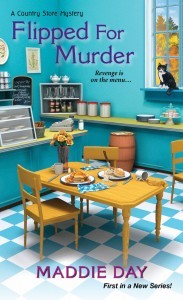 Hi. Barb here. Today my guest on the blog is Maddie Day, aka Edith Maxwell. Edith has visited before to talk about her Local Foods Mystery series. She’s a friend and fellow Kensington author and we also write together on the Wicked Cozy Authors blog.
Hi. Barb here. Today my guest on the blog is Maddie Day, aka Edith Maxwell. Edith has visited before to talk about her Local Foods Mystery series. She’s a friend and fellow Kensington author and we also write together on the Wicked Cozy Authors blog.
As Maddie Day, Edith has a new series out, the Country Store Mysteries, and the first book, Flipped for Murder, was just released. It’s set in southern Indiana, which makes Edith/Maddie the first Wicked to set a series outside New England. So I asked her to write about the regional differences. What is different and what is similar between a series set in Indiana and one set in Maine.
Take it away, Maddie!
Thanks for having me back on this great blog, Barb!
You remember those puzzles from when you were a child. Or maybe it was on the SAT test? Either way, how could Indiana possibly be compared to Maine?
 My new Country Store Mysteries series is set in southern Indiana, a part of the world I’m very fond of, where I spent five formative and glorious years – okay, part of them hungover – earning a PhD at Indiana University. I grew up on the west coast and am growing old on the opposite one, but there’s something very sweet about the middle of the country.
My new Country Store Mysteries series is set in southern Indiana, a part of the world I’m very fond of, where I spent five formative and glorious years – okay, part of them hungover – earning a PhD at Indiana University. I grew up on the west coast and am growing old on the opposite one, but there’s something very sweet about the middle of the country.
So I started thinking about things Maine and southern Indiana have in common.
 I could start with independent thinkers who live in the woods. Brown County, where I set the series, is hilly and pretty and looks a lot like New England, and harbors plenty of folks who’d rather be left to their own devices and opinions. I think that might be true of Maine, too.
I could start with independent thinkers who live in the woods. Brown County, where I set the series, is hilly and pretty and looks a lot like New England, and harbors plenty of folks who’d rather be left to their own devices and opinions. I think that might be true of Maine, too.
Then there’s colorful dialect. I’m not saying Mainers talk like Hoosiers, but they both retain a good number of regionalisms, both in pronunciation and expressions. Southern Indiana is really more Kentucky than Indiana, in my experience, and I’ve loved including phrases like, “That went faster than green grass through a goose,” “His drawer is all whopper-jawed,” and “Well, tie me to an anthill and fill my ears with jam!” I’m not personally acquainted with similar Maine phrases – other than ones from “Bert and I” sketches – but I’ll bet you hear them.
Both places traditionally eat a lot of potatoes, too. Am I stretching my luck here?

Maxwell Hall at Indiana University
What about an ocean, you say. All right. That’s in the category of How Are These Two Things NOT the Same. When I moved to Bloomington in 1977, I thought I would really miss the Pacific – so far the only ocean I knew – of which I was very fond and had grown up an hour’s drive away from. But you know, I didn’t really notice. When we wanted to cool off during our steamy grad school summers, we’d go swimming in a local reservoir or quarry. I still love the beach and the tangy smell of salt water, don’t get me wrong. I just did fine without it. Actually, it was during my time in grad school when I visited Maine for the first time, with a boyfriend who was from Kennebunkport and whose family had a house on Great Gott’s Island.
Readers: other similarities between Maine and Indiana, or any other midwestern state, that you know of?
About the book:
Flipped for Murder, the first book in the Country Store Mysteries series, releases October 27. The series features Robbie Jordan and Pans ‘N Pancakes, her country store restaurant in fictional South Lick, Indiana. When she remodels the store full of antique cookware and turns it into a local breakfast and lunch establishment, she doesn’t plan to have murder on the menu. But small-town secrets and bitter rivalries put sand in the batter and before Robbie knows it, her new life is a lot more complicated than she had expected.
Everyone in town shows up for the grand re-opening of the store, but when the mayor’s disagreeable assistant is found dead, Robbie realizes that not all press is good press. With all eyes on her, she’ll have to summon her puzzle-solving skills to clear her name, unscramble the town’s darkest secrets, and track down a cold-blooded killer–before she’s the next to die…
About Maddie Day

Edith Maxwell
Agatha-nominated and national best-selling author Edith Maxwell writes the Local Foods Mysteries and the Quaker Midwife Mysteries, the Country Store Mysteries (as Maddie Day), and the Lauren Rousseau Mysteries (as Tace Baker), as well as award-winning short crime fiction. Maxwell lives north of Boston with her beau and three cats, and blogs with the other Wicked Cozy Authors. You can also find her at www.edithmaxwell.com, @edithmaxwell, and on Facebook.
November 1, 2015
November
Lea Wait, here. And I’m grumbling that it’s November.
True, Maine enjoyed a glorious summer. Our only complaint was that some days were a bit too hot and humid. (Only people in New England would complain about temperatures in the high 80s.)
Our fall has been equally beautiful … and it has lasted. Spectacular color, cool-but-not-cold days, and leaves still on some trees.
But now it’s November. Day light savings is in effect, which means the sunsets we enjoyed at 8:30 last summer will now be at 4:30. We’re nearing the shortest and darkest days of the year.
The outside water has been turned off, the bird bath put in the barn. The porch furniture is now inside, and our supplies of biobricks and wood fill the barn, to fuel the wood stove in Bob’s studio.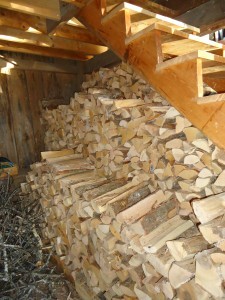
Storm windows and doors are in place. Balsam-filled “snakes’ are on window sills and in front of doors to help deflect winter winds.
Holidays are taking over. We just survived Halloween. (Sorry – all you witches and vampires and Trumps — it’s not my favorite day of the year.) Pumpkins and scarecrows are everywhere, and turkeys will soon be on sale in supermarkets, as well as parading across the lawn. Thanksgiving is the enemy of perpetual dieters like my husband and me. (Not that we diet then .. but we do feel slightly guilty!)

“Snake” in place
And then there’s Christmas. Since I’m married to a grinch and my children and grandchildren live far from Maine, I shop all year long, sort what I’ve found in September, and wrap in October. Right now I’m close to finishing the wrapping and have already prepared five or six cartons for mailing. There won’t be much more to do for Christmas except hang wreaths and maybe decorate a small Christmas tree. (With family miles away, there’s no excuse for baking. Unfortunately!)
 What will November be this year for me? I’ve already spent November 1 sharing a booth at a craft fair in Waterville with Kathy Emerson, where we sold our books and caught up on writerly gossip. Next weekend, November 6-8, I’ll be (along with most of the other Maine Crime Writers) at Crime Bake, a mystery conference in Medford, Massachusetts. On November 14 I’ll be speaking at Maine Coast Books in Damariscotta at 11. And November 19-22 I’ll be at Studio 53 in Boothbay Harbor with other writers, artists, and craftsmen, selling our wares to Christmas shoppers.
What will November be this year for me? I’ve already spent November 1 sharing a booth at a craft fair in Waterville with Kathy Emerson, where we sold our books and caught up on writerly gossip. Next weekend, November 6-8, I’ll be (along with most of the other Maine Crime Writers) at Crime Bake, a mystery conference in Medford, Massachusetts. On November 14 I’ll be speaking at Maine Coast Books in Damariscotta at 11. And November 19-22 I’ll be at Studio 53 in Boothbay Harbor with other writers, artists, and craftsmen, selling our wares to Christmas shoppers.
All fun, if exhausting, activities!
And somewhere in between those dates, and after, I’ll be writing. My next book (the 4th in the Mainely Needlepoint series) is due to my editor January 4. (I’ve already asked for an extension — it was originally due December 1.) And Bob will be painting. We may watch a NetFlix movie early in the evening instead of watching a sunset.
We’ll hunker down.
Because, beginning December 20, the days will start getting longer.
And that’s always something to celebrate.
Lea Wait writes the Shadows Antique Print Mystery series (the most recent of which is Shadows on a Maine Christmas) and the Mainely Needlepoint series (the most recent of which is Threads of Evidence.) Her Uncertain Glory and Finest Kind, historical novels for ages 8-14, have just been issued in paperback.
October 30, 2015
Weekend Update: October 31-November 1, 2015
 Next week at Maine Crime Writers there will be posts by Lea Wait (Monday), Barb Ross (Tuesday), John Clark (Wednesday), Kate Flora (Thursday) and Kaitlyn Dunnett/Kathy Lynn Emerson (Friday).
Next week at Maine Crime Writers there will be posts by Lea Wait (Monday), Barb Ross (Tuesday), John Clark (Wednesday), Kate Flora (Thursday) and Kaitlyn Dunnett/Kathy Lynn Emerson (Friday).
In the news department, here’s what’s happening with some of us who blog regularly at Maine Crime Writers:
from Kaitlyn Dunnett/Kathy Lynn Emerson: The next Kathy Emerson, Murder in the Merchant’s Hall, will be out December 1 but if you’d like a chance to win an early copy, I’m doing a giveaway at Goodreads until November 9. Here’s the link: https://www.goodreads.com/book/show/26265846-murder-in-the-merchant-s-hall
Meanwhile, this very weekend, (Saturday, October 31 from 10-5 and Sunday, November 1 from 10-3), Lea Wait and I will have a booth at the REM Craft Fair being held at 30 Elm Plaza (Champion’s Fitness Center) in Waterville, Maine. There will be about sixty dealers but we’ll be the only writers. Great place to get a head start on your Christmas shopping!
Lea Wait: My UNCERTAIN GLORY has just been published in paperback, in case anyone has been awaiting that day! And I just found out that my FINEST KIND will also be out in paperback about November 13. Just in time for holiday giving! (Those are both historical novels set in 19th century Maine.)
Brenda Buchanan has been out and about, talking about Cover Story, the second book in her Joe Gale Mystery Series. Last weekend she was over at the Local Buzz in Cape Elizabeth and at Walker Memorial Library in Westbrook. Next Thursday, November 5th, she will be on Peaks Island, reading and visiting at the library from 6 – 7 p.m.
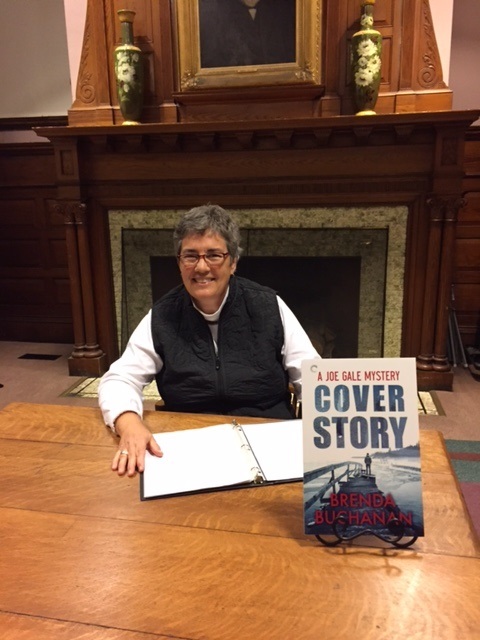
Brenda in the historic Gathering Room at Walker Memorial Library in Westbrook
An invitation to readers of this blog: Do you have news relating to Maine, Crime, or Writing? We’d love to hear from you. Just comment below to share.
And a reminder: If your library, school, or organization is looking for a speaker, we are often available to talk about the writing process, research, where we get our ideas, and other mysteries of the business. Contact Kate Flora: mailto: kateflora@gmail.com
Centipedes of the Mind, or Forget Fiction, Reality has Quite A Bite.

Grimmy in Wilton says hello.
Happy Halloween from the MCW Crew!
John Clark sharing an accumulation of things blog members and librarians passed on to me that have scared them spitless at some point in their life. We start off with Sister Kate Flora’s account of a gift gone really bad.

Not an exact match, but you get the idea.
Well, I’m one of those people who are easily scared, so I generally don’t take risks or read scary books. But here’s the moment when I thought for sure I was going to die. For his 40th birthday, I gave my more adventurous husband a hot air balloon ride. His birthday is in January, but the months ticked past, and finally in November, we heard from Mario, the balloon man, that the gift certificate was about to expire and he needed to take that ride.
We met up with Mario and his crew in a park in Worcester, Massachusetts, and at that point, my husband declared that he wanted me to go with him. Have I mentioned that I’m scared of heights? But I obligingly climbed into a basket about the size of a shower stall, with three other riders, four propane tanks, and Mario. And found that the basket didn’t even reach my waist. I nearly died of heart failure. Then Mario gave the balloon some hot air, his crew leaped off, and we popped up into the air and began to float silently over the city. People couldn’t hear us but the dogs went crazy. I reminded myself to breathe. There was no place to go.
As we floated, and the car that would pick us up followed on the streets below, Mario got increasingly agitated. It seemed that an unexpected storm system had come up, the wind was rising, and it became vital that he land the balloon as quickly as possible. It was clear that had he known about the storm, he would have canceled the ride. Now I was standing in a flimsy basket with four propane tanks, a balloon making a huge sail above us, the wind driving us relentlessly along, and Mario was frantically trying to land in an open field. Beyond the field was a sort of frozen lake.
And the balloon wouldn’t stop. The wind was pulling us along, half sideways, bouncing off the ground and into the air, right toward the lake.
As we crouched in our corners, terrified, Mario stood tall, trying to re-inflate the balloon. Blast after blast of fire and hot air. With a monumental effort, Mario got the balloon inflated enough so that we hopped over the lake, landing sideways in the next field, where we were dragged along for a while–shaken, not stirred–before the balloon finally stopped.
We all crept out of the basket, uncertain whether we were alive or dead. The balloon was torn. The field had recently been burned and we were all bruised and blackened. My husband’s camera and glasses were gone. I’d lost my hat. And Mario was bleeding from a great gash on his face.
In the van that was to take us back to our car, the celebratory champagne became medicinal, and despite our disheveled appearance, blackened hands and faces, and torn clothes, we headed for the nearest bar.

Some academics just don’t know when to retire.
Trish checks in with a hint at ghosties in an academic setting: “Not sure if this is scary enough but I have seen other presences both here at COA (College of the Atlantic) and in-town Bar Harbor. There are the feelings I’ve gotten going to the third floor of Turrets at night. (I don’t do that anymore.) Then there are the ghosts of COA… which I could dredge up stories….”
From Sandy Schmitz who is on the Maine Library listserv, but in California. “This happened about thirteen years ago. At that time I owned an older house in Oakland where I lived alone with my cat (a black cat, if that matters). One night I went to bed, leaving three bottles of bubble bath lined up on the sill of the bathroom window. The bottles were small, but since they were full, each bottle weighed about 8 ounces. They were lined up side by side along the sill, but not quite touching–there was less than a quarter inch of space between each bottle and its neighbor. It was a peaceful night, quiet and calm, and I fell asleep quickly.
About 1 AM I awoke for no apparent reason. A couple minutes later I heard a loud thunk just outside my bedroom door, as if something solid had fallen onto the floor. I assumed my cat had knocked something over, until I opened my eyes and saw that she was curled up beside my pillow. She had heard the noise too; her head was raised and she was looking at the bedroom doorway. I lay awake for about an hour but, hearing no further noises, went back to sleep.
The next morning, I discovered what had made the middle-of-the-night noise. It was the middle bottle of the three bottles of bubble bath. Somehow it had left the windowsill, flown ten feet across the bathroom, through the bathroom door, and landed on the floor just outside my bedroom. The other two bottles, which had been less than a quarter inch from it on either side, were undisturbed. I had checked that the doors and windows were closed and locked before I retired for the night, and the next morning found no indication of a break-in. USGS reported no earthquakes in Northern California. I have no explanation for what happened that night.”
(I had a similar experience in a Tempe, AZ. Bar while in college, saw an ashtray fly across the room to break up a fight and no one was within ten feet of it.)
From another librarian who wants to remain anonymous: “I have known not one, but two murderers. When I was a senior in HS a fellow drummer murdered a young girl. He had been practicing satanism, which we all knew, but when you are a teen you consider it a fad, not life threatening. The Monday following the discovery of the body we were hanging around together and he acted like nothing had happened. The trial continued through my Freshman year of college and was on the news almost every night.
So good readers, what chains clank in your reality? Inquiring readers want to know.
October 28, 2015
NaNoWriMo – a month of lovely obsession
(Note from Kate Flora: This is a revision of a post that has run before, with tweaks and links, etc.) But with NaNoWriMo coming fast upon us, we wanted to run it again in case you missed it and want to start gearing up for this November)
OBSESSION: Compulsive preoccupation with a fixed idea or an unwanted feeling or emotion, often accompanied by symptoms of anxiety. (American Heritage Dictionary)
One of the lovely dark sides of the writing life is obsession. This November, many writers will nurture (or yield to) this obsession. November is National Novel Writing Month, or NaNoWriMo, (http://www.nanowrimo.org/) a period during which writers all over the world sign up and commit to trying to write a 50,000 word novel during the month. Some get together in weekly support groups, or go to weekly “write-ins.” Some are supported throughout the month by a series of rallying e-mails from their local organizers. Some toil quietly in the stillness of their homes or the commotion of their local coffee shops.The project began in 2000 with 140 participants, 26 of whom met the goal.
In 2014:
325,142 participants, including 81,311 students and educators in the Young Writers Program, started the month as auto mechanics, out-of-work actors, and middle school English teachers. They walked away novelists.
803 volunteer Municipal Liaisons guided 615 regions on six continents.
849 libraries, bookstores, and community centers opened their doors to novelists through the Come Write In program.
55,774 Campers tackled a writing project—novel or not—at Camp NaNoWriMo.
Over 250 NaNoWriMo novels have been traditionally published. They include Sara Gruen’s Water for Elephants, Erin Morgenstern’s The Night Circus, Hugh Howey’s Wool, Rainbow Rowell’s Fangirl, Jason Hough’s The Darwin Elevator, and Marissa Meyer’s Cinder. See a full list of our published authors. http://nanowrimo.org/published-wrimos
The thing has gotten big enough that it has prompted a lot of discussion, including a column by Salon’s Laura Miller titled: Better yet, DON’T write that novel, http://www.salon.com/2010/11/02/nanowrimo/ in which she opined that the world doesn’t really need more writers, especially writers who are writing so intensely they’re “writing a lot of crap” and ignoring the need for revision. Instead it should celebrate readers. That, in turn, prompted Carolyn Kellogg, at the LA Times, to counter with: 12 Reasons to ignore the naysayers: Do NaNoWriMo. http://latimesblogs.latimes.com/jacketcopy/2010/11/12-reasons-to-ignore-the-naysayers-do-nanowrimo.html

Happily obsessive or in need of a tin foil hat?
Maybe others will think I should be wearing a tin foil hat, but I’m with Carolyn Kellogg. However a writer chooses to approach NaNoWriMo, there’s an incredible energy in the air that can be captured and channeled. It’s exciting to be part of a “movement” where more than 200,000 people are setting aside the complex demands of their lives and giving themselves over to a long held-dream, or a voice that won’t take “no” for answer. And the result, for some of us, is obsession, in the best possible sense of the word. Yes, a compulsive preoccupation. Yes, quite possibly accompanied by feelings of anxiety–though often those are the result of trying to figure out how to put the rest of life on hold or how not to burn the chicken when you haven’t met your daily word goal. And yes, perhaps almost impossible to do–but ultimately, the task is about jump starting, it’s about taking a turn down the to road of creativity. It’s about getting so deeply into story that those editing voices in our heads, the result of a lifetime of correction and discipline, are stilled, and the words just flow. For once, it’s possible to believe that it can all be edited and revised later, because there’s no time to stop. Fingers are flying, words are flying, there’s only time to get it down on the page.
I did NaNoWriMo five years ago and it was amazing. True confessions: First, I only got to about 42,000 words; Second, I broke the rules and used the time to try and finish a book I’d started and then hit the pause button on nearly a decade earlier. But since this is only about a writer’s personal relationship with the page, that’s okay. I’m the writer. You’re the writer. We’re using this as a device. This is NOT our homework, it is our life’s work, our dream work, our step-out-on-the-tightrope-and-see-what-happens work. Our writing, and the decisions about how to approach it, always, first and foremost, belongs to us.
So what did I learn from my NaNoWriMo adventure? First, that it should probably take place in February. November is an impossible month. I’m helping to run a huge weekend-long mystery writing conference, The New England Crime Bake. I’m teaching other mystery writers. I have a book to finish before I can start NaNoWriMo. But I’m not going to let any of that stand in my way.

And when you’re writing obsessively, you are there when lightning strikes!
Why? Because what I rediscovered when I did it before, something I knew from a long-ago stint to see how fast I could write a book (485 pages in 3 months), is that the upside of obsession is something akin to ecstasy. There’s something almost breathtaking about getting so deeply immersed in story and character that they begin to write themselves. There is a kind of magic in being in what some writers call “flow,” where the story just comes pouring out. Where characters are so freed to be themselves that they just start talking and we writers almost break our fingers as we try to write it down. Being that deeply in story is a high like no other that I’ve ever experienced (and since I may still run for political office, I’ll leave it right there). And quite honestly, as I sit here at my desk and look at my to-do list and my calendar, the passionate writer in me can hardly wait to shove everything else aside and write: Chapter One.
50,000 words. 1,666 words a day. I hope you’ll be joining me.
For some nitty gritty details and advice, check out guest blogger Steve Liskow’s post in our archives:
NaNoWriMo 101 or Some Planning Tips for Writing in November
And for other thoughts, blogs, ideas, and suggestions about tackling NaNoWriMo, here are some links:
Chuck Wendig on the Pros and Cons: http://bit.ly/1H8BeRD
Annie J. Kelley on getting some ideas: http://bcene.ws/1RyaYWl
Robin Rivera: A Writer’s Ode to her Inner Critic: http://writeonsisters.com/writers-life/a-writers-ode-to-her-inner-critic/ (We don’t know if his name is Carlisle)
Finally, a so painfully close to the truth, is this blog post from Chicks on the Case:
How Not to win NaNoWriMo
http://chicksonthecase.com/2015/10/26/how-not-to-win-nanowrimo/
October 27, 2015
A Vibrant Tapestry of Contentment
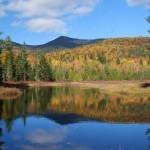
Bigelow Range
Bruce Coffin: A few weeks back, I spent a glorious sun-filled autumn day hiking in the western part of Maine along the Bigelow Mountain Range. The route I’d picked allowed me to cross yet another section of the legendary Appalachian Trail off my list. I’ve been tallying up sections as I complete them, determined to walk every inch of the 282 miles of trail running through the Pine Tree State. While Maine can only lay claim to about twelve percent of the entire trail, it possesses some of the most picturesque and rugged terrain to be found among the thirteen states through which the AT passes.
As always, I try and plan the majority of my fall treks during the height of foliage season, when deciduous trees dress up like starlets at a Hollywood premier and forests resemble an artist’s pallet. Maples are cloaked in breathtaking hues of orange and crimson, while oaks, elms, and birches don magnificent lemony yellows and golds. Warm autumn colors brilliantly juxtaposed with the cooler blue-green shades of pine, hemlock and spruce.
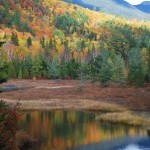
Bigelow Foliage
It’s difficult to convey in words the thrill that comes from lacing up a pair of well-worn boots and heading out into the Maine wilderness. Hiking during any season of the year can inspire, but autumn even more so. Dawn arrives, crisp and invigorating. Fallen leaves, coated with frost, blanket the path before me. The sun gradually warms the air as woodland creatures scamper about, and distant foothills morph from lavender into a fiery patchwork under cerulean skies. The scent of balsam, conjuring wonderful holiday memories, overpowers each breath. Roots, crisscrossing the trail, playfully grab at the soles of my boots, a constant reminder that I am merely a visitor here.
Admittedly, hiking is a little harder on my body than it was twenty years ago. I have to work much harder at the local gym to stay in trail shape. Much like life itself, hiking requires perseverance, the ability to forge ahead even when you don’t think you can. Mountains seem infinitely taller in person. A mile on the trail can easily seem like five. Legs feel like rubber, knees ache, and your pulse races. The payoff, of course, comes at the pinnacle of each mountain, where I pause to rest on a stone outcropping or ledge, letting the sun warm my face. I drink in both the cool water from my camelback and the magnificent view. A sprawling unmarred vista reminds me just how great it is to live in the Pine Tree State.

Horns Pond
And so, I return every fall, crossing paths with like-minded people of all ages and all walks of life, each of us in pursuit of nature’s gift, a vibrant tapestry of contentment and fulfillment, a recharging of the soul.
Have you hiked any of Maine’s Appalachian Trail? If not, what’s stopping you?
October 26, 2015
Selling a book? The number one tip to success for writers.
Maureen Milliken here. One of my favorite quotes is from Thomas Edison: “Opportunity is missed by most people because it’s dressed in overalls and looks like work.”
I remind myself of that often, because the point is that no matter how brilliant and talented you are — even Thomas Edison! — you have to work it.
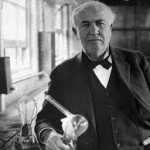
Even Thomas Edison couldn’t sit around being all talented and waiting for opportunity to come to him.
This is something writers sometimes forget once their book is published. They worked so hard to get there (at least most of them did, but that’s a blog for another day), that they want to relax and rest on their laurels. Well, for most of us, there really are no laurels. At least in the conventional sense.
Saturday, I drove down to Boston to spend one hour at the Sisters in Crime New England booth at the Boston Book Festival. It was a six-hour round trip, and since I didn’t want to try to find the one parking garage that would take the BBF voucher, it also included a 20-30 minute ride on the T — carrying a box of books that I knew would probably be almost as heavy on the return trip.
An acquaintance pointed out that I needed to sell a certain amount of books to even cover the gas, and even more to make it “worthwhile.” Technically the gas part is true.
But the worthwhile part?
I’ll add to Edison’s quote that not only don’t we recognize opportunity when it’s in front of us, but we also expect it to come knocking. Possibly because someone a long time ago coined that phrase then left it there for us to believe was reality. But how often does it really come knocking for people like me and you? You got it. Rarely, if ever. You have to go out and hunt it down, and it’s going to be wearing camo and hiding behind a tree.
When I began my career as a journalist more than 30 years ago, I vowed to never say no to an opportunity when it did come knocking. I carried that into my recent and brief (thankfully!) sub-career as a freelance editor. And now I have the same philosophy as a recently published author — a sub-career that I hope will carry me through the final decades of my life. And the thing about opportunities “knocking” is that you have to, as Edison pointed out, recognize them. And realize the knock isn’t going to be on your front door and isn’t going to be accompanied by another hand clutching a big bundle of cash for you.
My feeling about that trip to Boston is if I sold any books, great. But it was about more than that. It was about getting out there, meeting people and talking writing, books — my book and other people’s. It was about showing up. Another wise and talented person (it’s credited to everyone from Woody Allen to Mario Cuomo, but you get the idea, someone witty and wise) is that a certain percentage (80, 99, 50, whatever) of life is showing up. That’s certainly true for selling your book.

Whoa! Someone likes my book. Fellow writer John Radosta stops by to say hi at the 2015 Boston Book Festival.
Some of that can be done from the comfort of your living room. The Internet has made it possible for people like you and me and my small publisher to get the book out there, to blog (like this!), tweet, Facebook, email, sell online, hope people blog about you, review you on Amazon, add you to their Goodreads list.
But you gotta show up in person, too. I always feel that I never know what conversation I have, what postcard I give out, what book I sell, is going to make a difference. And on top of that, every single person I talk to and event I attend builds a foundation. I’m not going to go home and find that I sold 500 books on Amazon after an event, or see a review of my book in People magazine. I know that. The benefits of the event, though, will show themselves in ways big and small.
I have never gone to an event and regretted it. In fact most of them not only boosted me as a writer, but as a person. I feel lucky to have the opportunity, no matter what it was wearing.
And speaking of opportunity, I’m on my way today to the New England Library Association Conference, another six-hour round trip. By the time you read this, who knows who I may have talked to? Who may have taken a look at my book and loved it? I can’t wait.
Because who am I to overlook an opportunity?
Maureen Milliken is the author of Cold Hard News, the first in the Bernie O’Dea series. She is also a newspaper editor in central Maine. Follow her on twitter at MMIlliken47, check out her Facebook page, Maureen Milliken mysteries. Thanks for reading!





